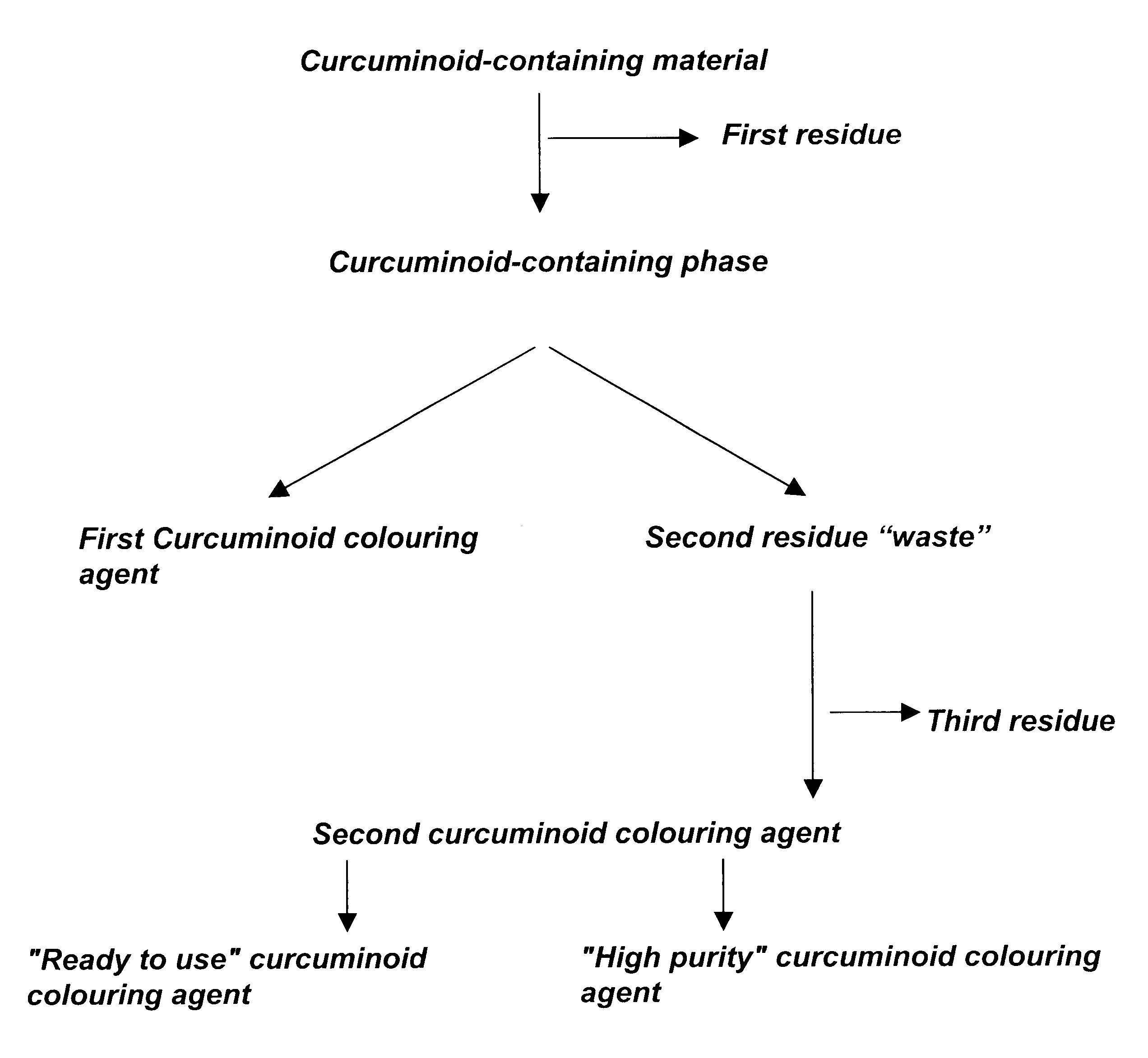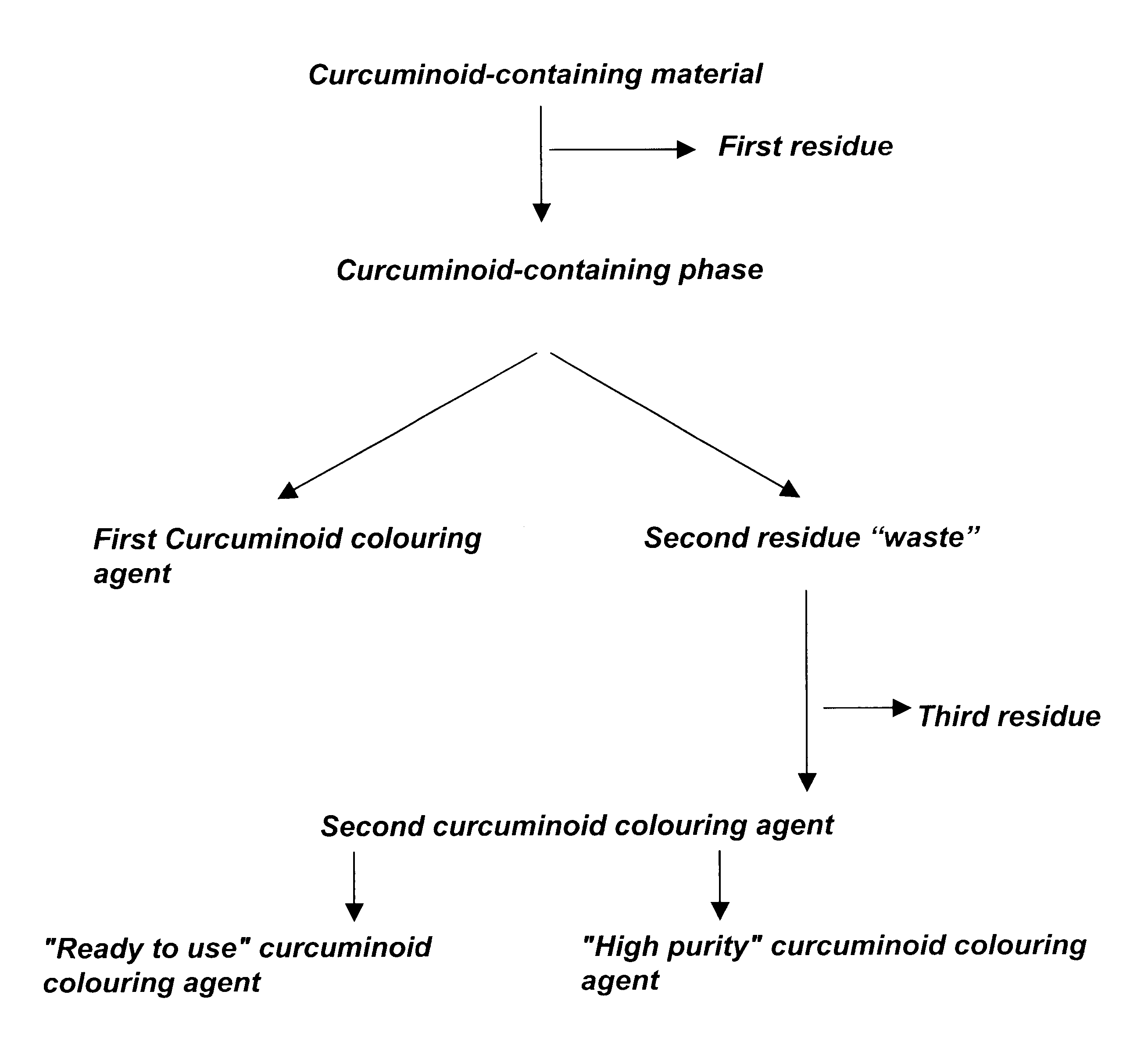Purification process for improving total yield of curcuminoid colouring agent
a technology of curcuminoid colouring agent and purification process, which is applied in the directions of biocide, plant/algae/fungi/lichens ingredients, unknown materials, etc., can solve the problems of rhizome hardness, uniform yellow colour, strong and bitter taste, etc., and achieves enhanced light stability
- Summary
- Abstract
- Description
- Claims
- Application Information
AI Technical Summary
Benefits of technology
Problems solved by technology
Method used
Image
Examples
example 1
Analysis of Curcuminoid Contents in Samples of Fresh Curcuminoid-Containing Plant Material, Turmeric Oleoresins, Curcumin Powders and Waste (the Second Residue).
Information from industrial processes to obtain curcuminoid colouring agents and information of the curcuminoid contents in the end product is very limited as the processes are regarded as restricted information by the firms. Accordingly, a study of the products on the market was performed, covering different raw materials, turmeric oleoresins and commercial curcumin powders in order to gain information on the currently used processes for extraction of the colouring compounds from the raw material. Furthermore, samples of the second residue resulting from the crystallisation process was obtained and analysed.
The colouring compounds of turmeric, as described hereinbefore, consists of the three colouring compounds curcumin (C), demethoxycurcumin (DMC) and bis-demethoxycurcumin (BDMC). These colours were synthesised, and using ...
example 2
Improving Yield by Refluxing the Second Residue in Hexane.
To the second residue hexane was added in equal amounts in a flask. The mixture was refluxed for 30 minutes. During reflux an oily phase at the bottom was observed. The sample was cooled and left for 1 month. A sticky precipitate containing the major part of curcuminoids was observed. The experiment clearly showed that refluxing in concentrated hexane was not adequate to obtain a useful product.
example 3
Extraction of the Hexane Extractable Oil by Changing the Hexane / Acetone Ratio.
Hexane and acetone was added to the second residue (12:3:10). The mixture was refluxed for a couple of hours and left overnight. The solvent contained only small amounts of curcuminoids and the fraction of acetone was increased in two steps to an amount that resulted in a mixture of hexane, acetone and the second residue in a ratio of (12:8:10), respectively. After adding half of the acetone the mixture were refluxed for 1.5 hours, then the remaining acetone was added and the mixture was refluxed for 1.5 hours. The sample was transferred to a refrigerator and left overnight. After 3 month in refrigerator the result was a sticky useless powder.
PUM
| Property | Measurement | Unit |
|---|---|---|
| temperature | aaaaa | aaaaa |
| temperature | aaaaa | aaaaa |
| organic | aaaaa | aaaaa |
Abstract
Description
Claims
Application Information
 Login to View More
Login to View More - R&D
- Intellectual Property
- Life Sciences
- Materials
- Tech Scout
- Unparalleled Data Quality
- Higher Quality Content
- 60% Fewer Hallucinations
Browse by: Latest US Patents, China's latest patents, Technical Efficacy Thesaurus, Application Domain, Technology Topic, Popular Technical Reports.
© 2025 PatSnap. All rights reserved.Legal|Privacy policy|Modern Slavery Act Transparency Statement|Sitemap|About US| Contact US: help@patsnap.com


